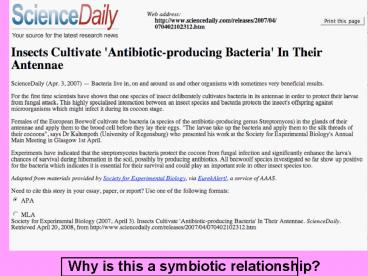Why is this a symbiotic relationship - PowerPoint PPT Presentation
1 / 22
Title:
Why is this a symbiotic relationship
Description:
Slowly glide along a layer of slime like material they secrete. No movement at all ... from one bacterium to another by a bacterial virus (virulent bacteriophage) ... – PowerPoint PPT presentation
Number of Views:84
Avg rating:3.0/5.0
Title: Why is this a symbiotic relationship
1
Why is this a symbiotic relationship?
2
Bacteria
- Cell type Prokaryotes
- Archaebacteria and Eubacteria
- Identifying bacteria
- Shape
- Arrangement
- Colony characteristics
- Cell wall
- Movement
3
Arrangement
- Strepto - Chain
- Staphlo - Cluster
- Diplo - Pair (two cells)
4
Coccus arrangements
http//student.ccbcmd.edu/courses/bio141/lecguide/
unit1/shape/dkstaph.html
5
Bacillus arrangements
http//student.ccbcmd.edu/courses/bio141/lecguide/
unit1/shape/dkstaph.html
6
Spirilla arrangements
http//student.ccbcmd.edu/courses/bio141/lecguide/
unit1/shape/dkstaph.html
7
Bacteria movement
- Flagella
- Lash, snake, or spiral forward
- Slowly glide along a layer of slime like material
they secrete - No movement at all
http//www.aenvirocure.com/DB_DATA/contams/organic
/images/bacteria_pili.jpg
8
http//www2.bc.cc.ca.us/bio16/Lab20Manual/Lab20W
Eb20Exercises/lab_exercise6.htm
9
ENERGY!!!!!!!!
- Autotroph
- autos self, trophe nutrition (Greek)
- Heterotroph
- heterone (an)other, trophe nutrition
- (Greek)
10
Photoautotrophs
- Found where light is plentiful
- Carry out photosynthesis
- Cyanobacteria
- (found all over - including in
- hot springs and the Arctic one
- of the first species to recolonize
- areas after a natural disaster)
http//en.wikipedia.org/wiki/Cyanobacteria
11
Chemoautotrophs
- Obtain energy directly
- from inorganic molecules
- Chemical reactions involving ammonia, hydrogen
sulfide, nitrates, sulfur, and iron
Hydrothermal Vent
http//www.daviddarling.info/images/hydrothermal_v
ent.jpg
12
Heterotrophs
- Most prokaryotes
- Obtain energy from taking in organic molecules
(like HUMANS do) - Photoheterotrophs! - capture sunlight for energy
AND rely on organic compounds for nutrition
13
Once you eat, you Grow!
- Favorable conditions
- Bacteria dividing every 20 minutes would reach a
mass 4000 times the mass of the Earth in 48
hours!!!!!!!!!!!!!!!!!!!!!!!!!!!!!!!! - Limiting factors prevent this
- -Food
- -Space
- -Waste products
14
Bacteria in a mouth after a visit to the dentist
(8 hours)
15
Binary fission
- Asexual reproduction of bacteria
- Cell doubles in size, then DNA replicates, and
the cell divides in half - producing two
identical daughter cells
16
Exponential growth. But why arent we drowning in
bacteria?
17
- A - LAG PHASE Growth is slow at first, while the
"bugs" acclimate to the food and nutrients in
their new habitat. - B - LOG PHASE Once the metabolic machinery is
running, they start multiplying exponentially,
doubling in number every few minutes. - C - STATIONARY PHASE As more and more bugs are
competing for dwindling food and nutrients,
booming growth stops and the number of bacteria
stabilizes. - D - DEATH PHASE Toxic waste products build up,
food is depleted and the bugs begin to die.
18
Conjugation
- Transfer of genetic information by cell-to-cell
contact
Sex pilus
http//trc.ucdavis.edu/biosci10v/bis10v/week7/20f/
Slide4.gif
19
Transduction
- Transfer of genetic information from one
bacterium to another by a bacterial virus
(virulent bacteriophage)
http//pathmicro.med.sc.edu/mayer/trans-2.jpg
20
A brief film
- Please write down a sentence explaining the
following terms in your own words. - Conjugation
- Transduction
- Transformation
21
(No Transcript)
22
Homeworkdue this Friday
- Research a particular type of
- bacteria and draw a picture of it.
- Include
- Drawing, including labels of general parts and
specific characteristics of that bacteria - Information on arrangement, colony, and shape
characteristics - Metabolism (energy obtaining) information
- Special features where found, interesting role
in environment, etc.

